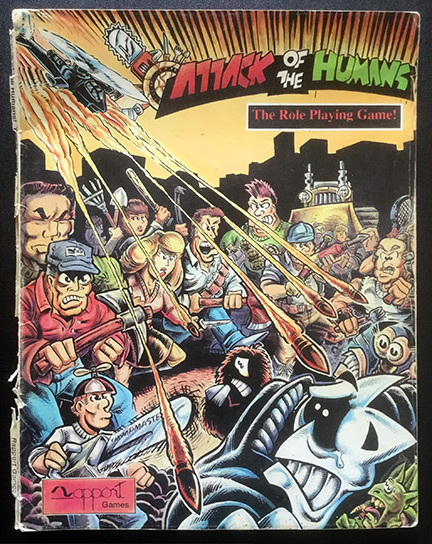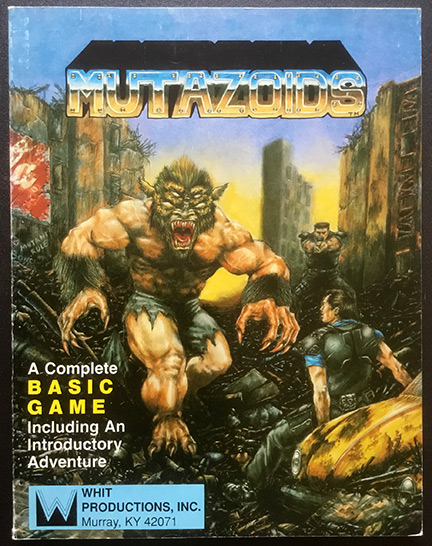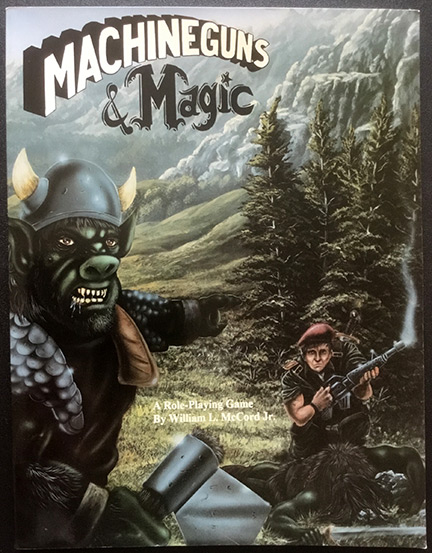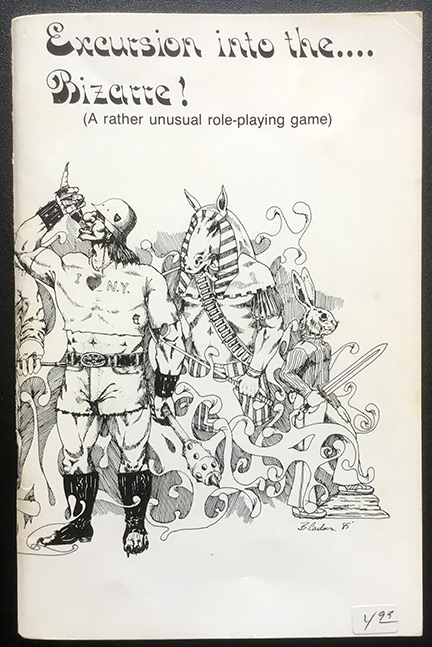This is part 5 in a series discussing forgotten RPGs (Part 1 can be found here, Part 2 here, Part 3 here, and Part 4 here). That is, games most people have never heard of or that didn't last long on store shelves for one reason or another. This batch consists of strangeness, odd games that belong in categories all their own. These games have been sitting on my shelf for years, mostly ebay finds to add to my collection.


1. Attack of the Humans (by Devin Durham; published by Rapport Games in 1990)

Now falling apart, this game is a humorous take on monster-hunting. There are three types of characters: brainiac, athlete, and typical person. These determine the values for the three attributes: brains, fitness, and common sense (a mix of two 5s and a 10 for the first two, and all 7s for the latter type). A character's IQ can be calculated by adding brains to half of common sense, and multiplying it by 10. Fitness describes how many pounds a character can benchpress, which is its rating multiplied by 15. A number of rolls are made for each attribute based on the rating. This provides a random skill or bonus, with duplicates increasing its level. Using a skill is as simple as rolling less than its level on a d6, with 6 always being a failure. Combining skills for a task increases the odds. For combat, a d6 and d10 are rolled, needing to roll under or equal to a base of 8. Skills, weapons, and other factors can augment this value. It's a very simple system. As expected, there are a bunch of monsters described, such as blobs and chainsaw creatures, spanning pages 46 to 73. Sample adventure material completes the book. It's basic. It's less than serious. Most importantly, it would make a great one-shot.




2. Mutazoids (by Ken Whitman and Christopher Wilkey; published by Whit Productions in 1989)

The short version is that someone created a cancerous plague that killed a lot of people. New governments formed, old ones were reborn, and some infants were being born with deformities. The characters are Enforcers tasked with keeping the peace by defending the public against the Mutazoids, or the dangerous deformities. There are seven primary attributes (rated from 2 to 12): physique, constitution, dexterity, intelligence, power, charisma, and perception. Rank and years on the force are randomly determined. Skills are rated from 0 to 12, and are gained randomly by rolling on charts according to years on the force. Creating non-human characters (superhumans, mutazoids, and acceptables) are also possible, so there are lots of tables and other info for mutations and powers. Fun stuff. Doing things requires the Universal Task Roll Table, which cross-references skill/attribute level and difficulty to determine a value that must be rolled equal to or under on 2d6. Combat pretty much works the same way, with options to modify difficulty. There's lot of stuff covered here, including falling damage, vehicle combat, and using drugs. The last part of the book touches on Enforcer rules, laws, setting material, and gamester notes. This game is very representative of the era, both system and setting-wise. I like it. While the system is not my favorite, it is serviceable. Note that this is the first edition, but there is also an updated second edition with more setting material. These appear to be available again through FireSide Creations, as is a third edition that is d20 compatible.





3. Machineguns & Magic (by William L. McCord Jr.; published by MG Games Inc. in 1991)

Did you ever want to pit a group of soldiers against a horde of orcs? Here's your chance. That's pretty much all this game is about, but it's a unique concept. There are three primary stats: muscle, agility, and alertness. Each one is rated by a d% roll, and modified by +30, +20, +10, or 0 for each (depending on the original value and a roll on a table). There are two secondary stats: magic resistance (derived from primary attributes) and luck (50). There are also personality facets and these can create conflicts in the game. Checks and saves are done by rolling d% under the primary stat. Combat is pretty much a check, but the higher successful roll (attacker vs. defender) wins. Magic is very similar, with spells defining the type of defense (none, magic resistance, etc.). After ALL the rules, we have a bunch of creatures like skeletons and slimes. Most have special rules attached. We round out the book with an adventure called The Quest for the Gem of Purity. I don't know what else to say. I have mixed feelings. It's got lots of examples to explain it, but I'm not a fan of the organization. It seems to cover all the bases, but feels lacking. The character sheet is reminiscent of the classic Traveller sheet by its organization.

UPDATE: Machineguns & Magic is now part of the Precis Intermedia family of games. I acquired the rights after learning of the author's passing, as I have a soft spot for this title, particularly the writing. I believe that this game deserves more attention, as does William McCord's legacy.




4. World Tree (by Bard Bloom and Victoria Borah Bloom; published by Padwolf Publishing in 2000)

This is a "roleplaying game of species and civilization." The world is a big tree. And it is populated by intelligent animal species. I don't understand about the tree, but sure. The first 100 pages details the setting, various species, and all that important info. 100 pages! That's a lot of setting before any rules. I'm not really into animal species as a whole, and it's a lot of information to remember as a gamemaster or player. So far, I'm not into it. We are first presented with attribute/skill rolls, which are d20 + attribute + skill equal to or greater than a difficulty. Combat is essentially highest roll. There are 10 attributes (rated from -6 to +6, although -1 to +3 are common): strength, stamina, dexterity, agility, perception, faith, memory, wits, will, and charisma. Skills seem to range from 1 to 20, though those tops levels are likely not going to be seen for a while. Everyone gets magic. Some of these spells have great names, like carry the slain beast and heal the body's weapons, though most are mundane. For species, we have dog folk, bear folk, isectoids, octopi, dragons, and the usual suspects (though they are given custom names, making them hard to remember). Lots of discussion on skills, combat styles, magic, and the like. Keep in mind that this book is over 300 pages and the type is very small. It's a lot of reading and it's a drag. Don't get me wrong. There is a lot of interesting stuff in here, particularly the magic. The art is typical for anthropomorphic animals, but the bestiary section let me down in the art department, and everything has a custom name that doesn't connect with the creature. That means I won't remember anything. This game needs a really good gamemaster to immerse his players in a very alien world. It needs players willing to accept that world. My suggestion is to mine the setting and magics for ideas for other games.




5. Dallas (by James F. Dunnigan; published by SPI in 1980)

Yes, it is Dallas, the television series as an RPG. Guess what. It's not bad. This is a boxed set with several booklets. The main rules are only 4 pages, but with the usual SPI small print (the rest of the booklet contains episodes, or adventures). There are 4 abilities, split into affect/resist values: persuasion, coercion, seduction, and investigation. Wow. That actually does sum up the show. Characters also have power (general strength for negotiating and overcoming conflict) and luck. All the minor characters are described on small cards, while the major ones are contained in a separate booklet. Here's the interesting part of the game. You can persuade, seduce, or coerce minor characters so that you gain control over them -- your major character essentially allows you to control them. Back to rules. You subtract the resisting ability from the affecting ability rating (modified by power and special bonuses). You need a difference of 2 to 11 to make a dice roll, with 12 or more automatically successful. The dice roll must be equal to or less than the difference to succeed. A luck roll is also possible by the resisting character (roll equal to or under luck rating). There is a scriptwriters guide booklet with director's notes and character biographies. The game is limited in scope, but I think it does a great job of emulating the series. Home run in my opinion, though it will not replace your regular RPG.




6. Excursion into the Bizarre! (by Wolfgang Trippe and Brian Carlson; published by Blind Dog Games in 1985)

Kudos if you've heard of this one. This is a rather odd duck. It claims to be a complete game, but is it? Here's what it is. You can play an animal character from the dimension of Chon-Blu or a fantasy character from the magical dimension of Oort. And apparently, you have unreliable magic skills. Great. Characters get five traits (roll 5d6, dropping the lowest die for each): strength, constitution, agility, intelligence, and wisdom/intuition. Using a trait means rolling equal to or under your trait rating. One problem: what dice do I roll? If attributes can range from 4 to 24, what die or die combination would work? Do I roll 4d6? It just does not say. It merely says to make a die roll*. Let's move on to skills. The number of skills you get is determined by your intelligence, but you can't start with earth skills (those marked with an E, like compound bow and paramedic). Divide 250 points among your skills to determine a percentage for each. Wait. That means if you get fewer skills, they get rated higher, because there are fewer skills to worry about. Does that sound right? So if skills are percentage-based (roll equal to or under their rating on d%), does that mean that the attribute's rating is also a percentage? Attribute rolls are also d%? This section is followed on info about the dimensions from which you may have come before reaching Earth. Some weird stuff. There's talk of enemies (like IRS and Miami Vice), allies (such as Steven Spielberg and the Libertarian Party), and neutrals (like mental patients and punkers) on Earth. And human reactions to dimensional invaders get a roll. Let us not forget magic. Casting a spell depends on how long the character has been on Earth, more time being better, but still not with great odds. Here we go with combat. We're mixing it up. Consult a table with each side's agility for hand to hand, rolling equal to or over the shown value on a d20. Melee is different. For every 5% in a weapon skill, subtract 1 from 20 -- roll equal to or under this on a d20. It talks about a parry, but what happens when it is successful? Does the successful attack just miss? Firearms just seem to be random with modifiers applied. My brain is starting to hurt trying to decipher the rules. There's some scenarios and a few random tables to round out the game. I remember being excited to get this game, because it sounded cool. Unfortunately, it was a real let down.

*EDIT: Turns out there is a line of errata in small type after the adventure on page 55 that explains saving rolls against character traits are made with 4d6.




I think we'll double back around to fantasy next time.


Part 6... |







